
Outline of exhibition
In the future, when we will be unable to distinguish between the real world and the simulated world, what will be our view of nature and the world, and what questions will we find?
The computers that we created are now overflowing in the world, and the resolution and processing power of the world they create is exceeding the limits of human perception and intelligence. In the near future, the difference between original nature and computer-created nature will fade away, a "new nature" will appear for us in the future, and we will be unaware of the differences.
Imagine that the vast natures both inside and outside the computer are integrated, then think about how our view of nature and the world will change, and what questions we will find.
- Location
- 3F (Create your future)



Supplementary explanations for exhibits available here.

Today, the world is overflowing with computers we have created, and computers can be seen almost everywhere. But nature also exists within computers, and that inside nature is drawing closer to the nature that has already existed outside. Soon the "within" nature will merge with the "outside" nature to create one enormous, combined nature. When this new nature is created, what kind of questions will we discover?
Credits
Supervisor & Art Director: Yoichi Ochiai (Media artist / Associate professor, University of Tsukuba)
Space Design: noiz
Space Detailed Design & Construction: TSUMURA KOGEI Co., Ltd.
Exhibit Design & Fabrication: TASKO inc., TSUMURA KOGEI Co., Ltd.
Video Content Design & Production: Hoedown Inc.
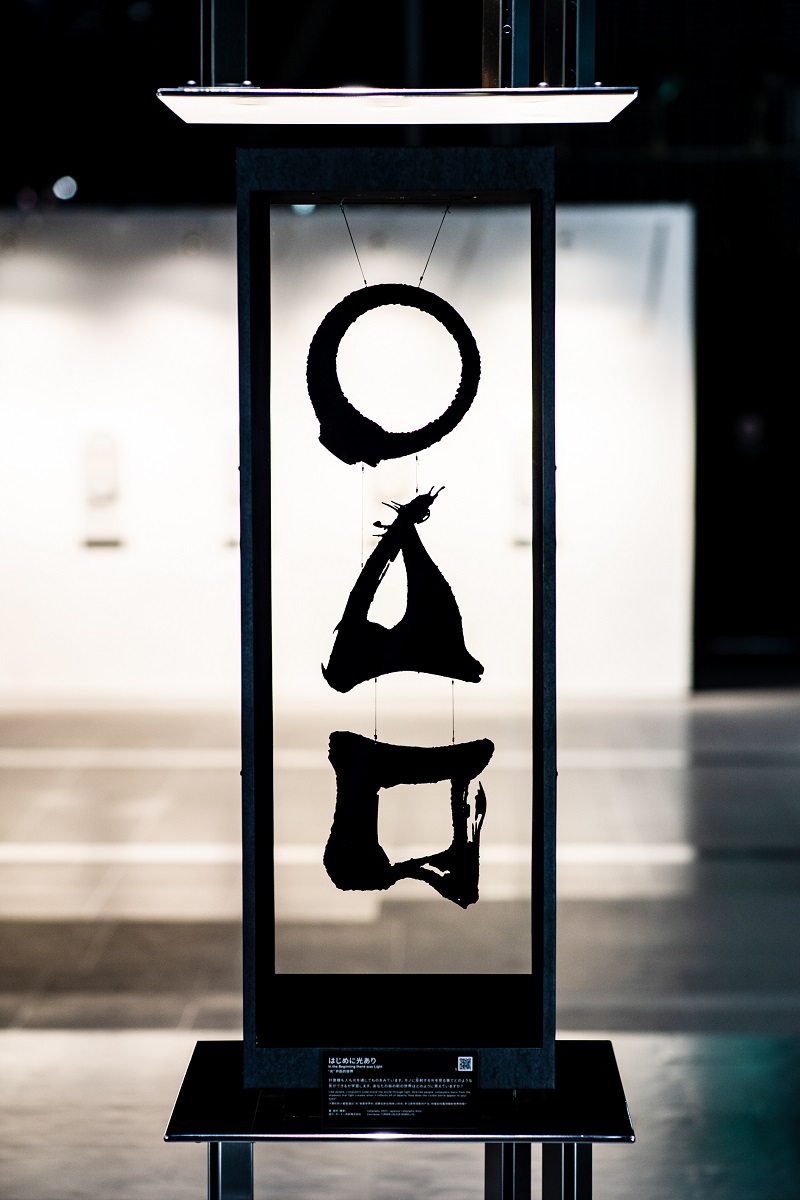
This exhibit explores light and vision and their relation to our spatial perception. The black object floating in space is based on the three shapes drawn by the calligrapher SISYU. Long ago, the Edo period Zen monk Sengai drew the three symbols "○ △ □" to provoke a viewer's thoughts.
What we see is reflected light, not the object itself. Based only on the information provided by this reflected light, however, our brain can see the object. Light alone does not provide enough information to perceive space, but our brain uses prior knowledge such as, "shadows always appear under objects," combined with the shape and the size of objects to estimate of our visual surroundings.
Related keywords
Light / Photon / Vision / Spacial perception / Computer graphics / Sengai Gibon
Credits
Calligraphy: SISYU(Japanese Calligraphic Artist)
Contributor: TURNER COLOUR WORKS LTD
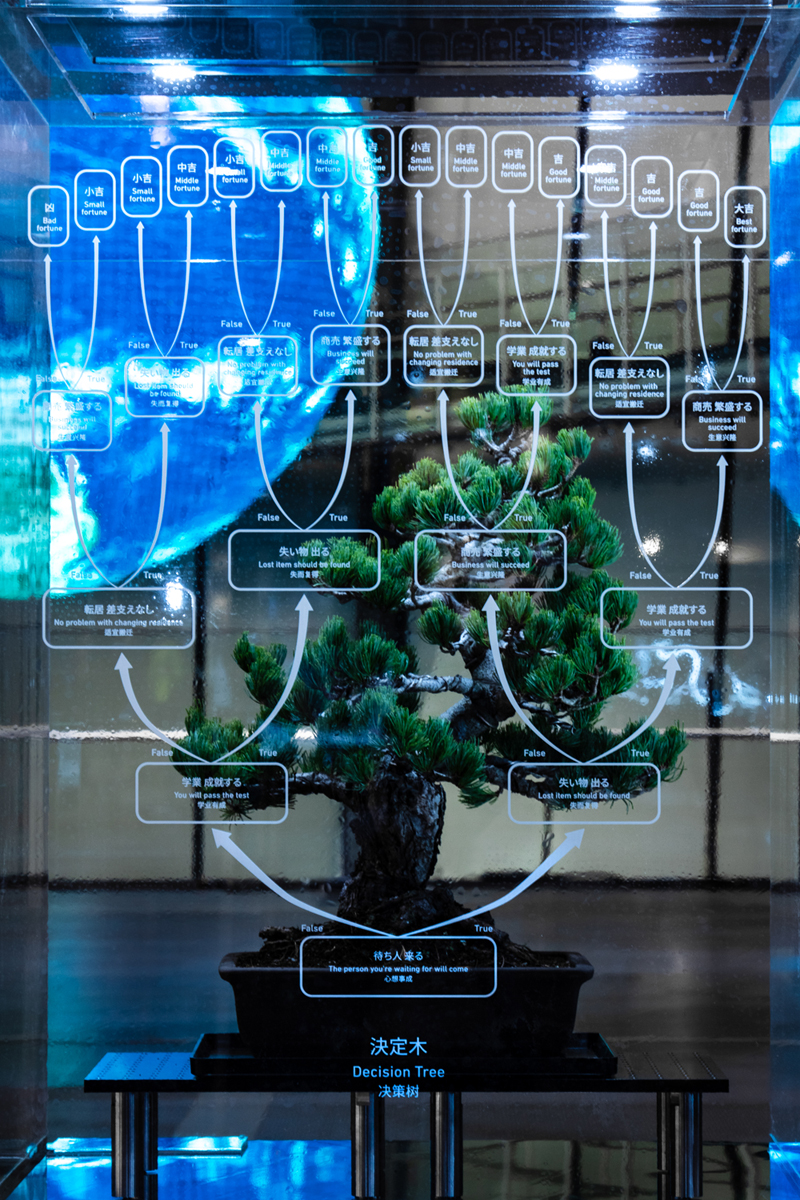
There is a "tree" in the world of computers. A "tree" is made of points called "nodes" and connecting branches called "edges." Just like a natural tree, computer trees grow from their "root nodes" to their "leaf nodes." A collection of computer trees is even called a forest.
Computer "trees" that are specifically designed for prediction and classification are called "decision trees." Questions are placed on every node of the decision tree, and the answer determines the next branch to follow. You can classify data based on the final leaf node arrived at after making a journey from a root node. This is one job of computers to create such "decision trees" by analyzing vast amounts of data. The organized tree of data helps us to understand important points suggested by data.

Related keywords
Tree structure / Decision tree / Average information volume / Mikuji lottery / Bonsai / Statistics
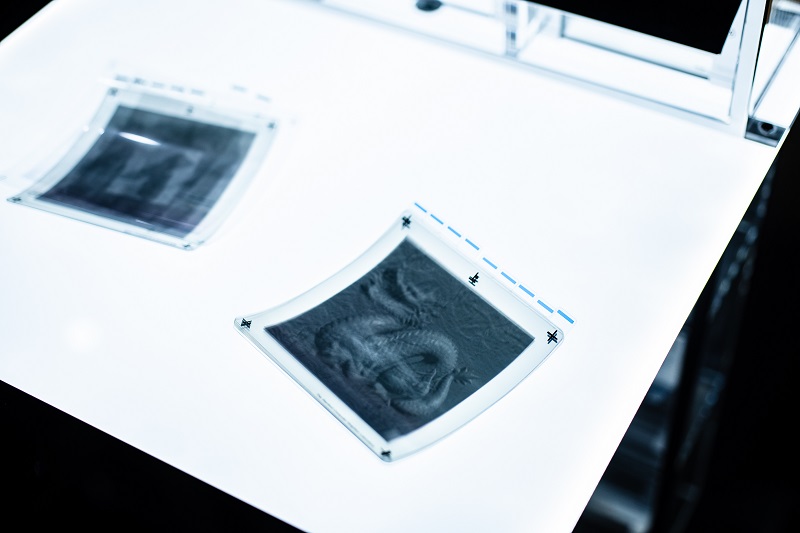
A "two-dimensional Fourier transform" is a method of decomposing image as waves. The image is like a wave spreading over a lake. For grayscale images, the highest waves are represented as the darkest blacks. You can see such waveform as stripes in the transformed image. The gap between the stripes may be narrow or wide, and the direction of stripes may be vertical or lateral. These various waves overlap to create a single image.
"Two-dimensional Fourier transforms" are commonly used in image processing, such as image compression. Because high-frequency waves indicated as fine stripes in a decomposed image are nearly invisible to the human eye, the image can be compressed by reducing such wave components.

Related keywords
Pixel / Resolution / Two-dimensional Fourier transform / Wave / Image processing / Eadweard Muybridge / Takayanagi TV / Stanford bunny / Stanford dragon / Utah teapot / Cornell box / Cat paper / Hatsune Miku
Credits
Image provider: CRYPTON FUTURE MEDIA, INC.
Contributor: Takayanagi Memorial Hall, Shizuoka University
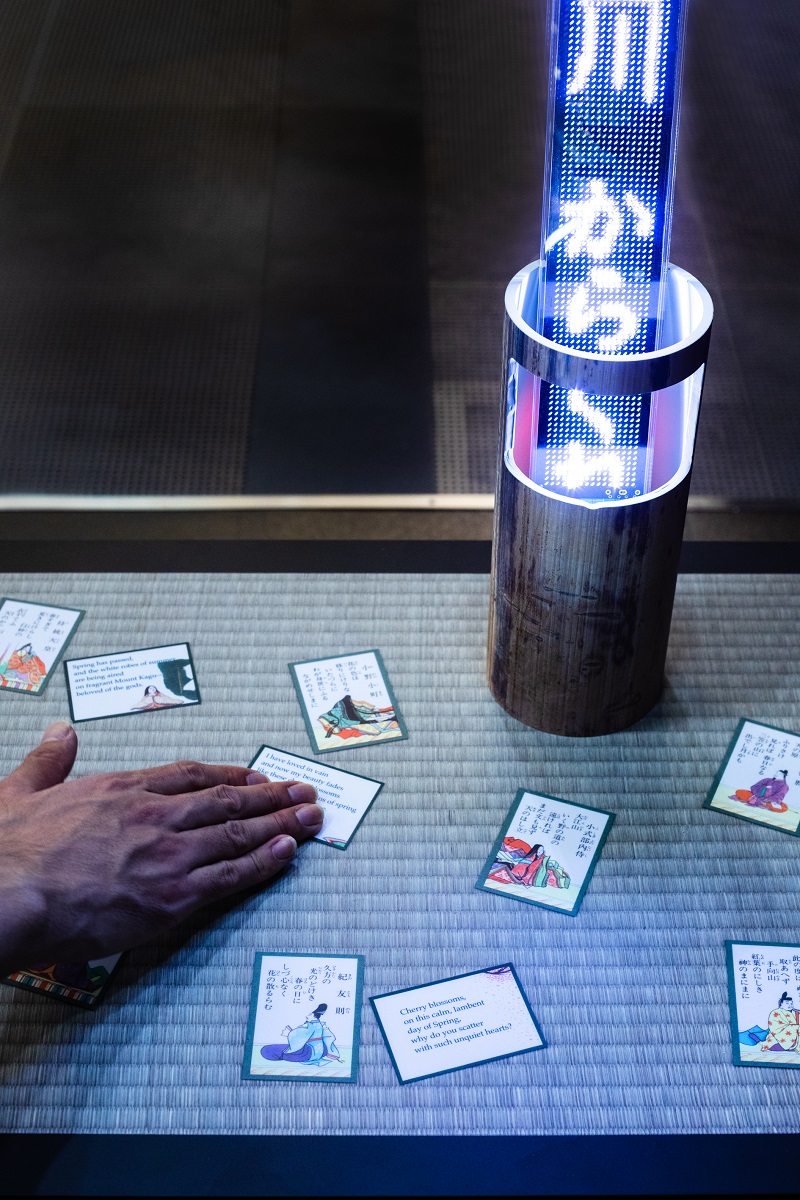
"Seeing is believing" is an old saying. In the present, or future age of digital reproduction with developing tools such as cameras, displays and printing, even seeing might not be enough. The tatami mat, Hyakunin Isshu, and bamboo vase you see here are all printed materials on the surface of objects. They might seem to have the rough texture of the tatami mat, or the smooth fibrous texture of the bamboo vase, but if you touch these objects, you will know what you see is not what actually exists. These prints were made using a special photo scanning technique for three-dimensional objects. In addition to extremely high resolution, the technique accentuates small shadows on the surface of objects. We "feel" a texture by looking at such small shadows.
Related keywords
Digital copy / Scanning / Hyakunin Isshu/ Texture / Perceptual psychology
Credits
Special Sponsor: Newly Corporation
Contributor: Peter MacMillan

The result of random events such as the roll of a dice or an experiment can be represented as a graph or mathematical formula called a "probability distribution." The distribution can be classified into several types according to the nature of each event. When you roll a die, each number from 1 to 6 has the same chance of happening to give a "uniform distribution." When values occur with a symmetrical frequency around an average value, the probability will be a "normal distribution."
By analyzing collected data, you can see a probability distribution and the rules it follows. Natural phenomena often follow a "normal distribution." Rainfall, sunshine, our height or weight, and even your personal actions may follow a normal distribution.

Related keywords
Probability distribution / Normal distribution / Gaussian process / Statistics / Big data / Operations research

"Support vector classification" is a method used in machine learning to classify data. For example, if you wanted to classify flowers, you would prepare a large amount of data with various parameters such as petal length and calyx width, and use this data to train the machine by providing it classification of all the flowers in the data in advance. Next, when you provide the machine with unknown data, the support vector classification method can be used to categorize the data based on the boundaries the machine has learned.
The "kernel method" is often used to find boundaries. This method maps data to a high-dimensional space using a nonlinear transformation. This allows support vector classification machines to discover boundaries with high accuracy, even if linear separation using a single straight line is impossible.

Related keywords
Programming language / C language / "If" statement / "For" statement / "While" statement / "Switch" statement / SVM / Kernel method / Classifier

This structure made of tree branches was created with the help of a computer. Natural branches with an irregular shape were previously unusable, but a computer can calculate the best arrangement to achieve a target structure. A computer numerical control (CNC) lathe is used to carve the joints of the branches, and all you have to do is assemble them in order to produce the final structure. Thus, computer science enables a new form of manufacturing completely different from the way industrial products are commonly produced today.
Related keywords
Standardization / Computer numerical control / Optimization / Natural variation / Industrial product
Credits
Collaborative Researchers: Hironori Yoshida (The University of Tokyo, Preferred Networks, Inc.), Maria Larsson (The University of Tokyo)

A standard metallophone consists of rectangular sound boards, with long bars that play low sounds, and short bars that play high sounds. The shape and size of the sound board determines the sound of the individual bars, so it is challenging for humans to easily design a sound board. A computer, however, can simulate the sounds produced by the sound board while testing various materials and shapes in real time, allowing a greater freedom in design. The metallophone on display is designed in the shape of the sound frequencies of do-re-mi.
Related keywords
Computer processing / Frequency / Eigenvalue / Instrument / Interactive design
Credits
Collaborative Researcher: Nobuyuki Umetani (The University of Tokyo)
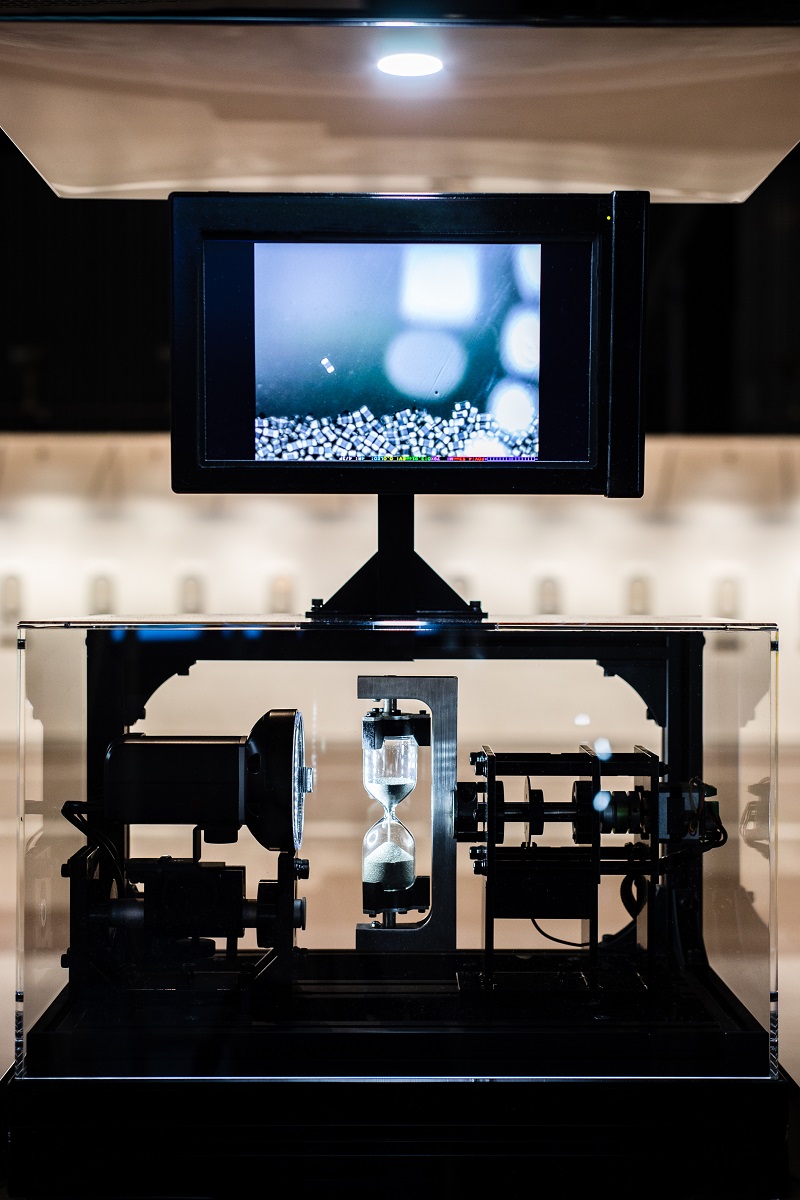
This hourglass contains a small electric component just 0.2 x 0.125 mm in size, called a "multilayer ceramic capacitor." About 700 of these parts are used in a single smartphone, and more than two trillion multilayer ceramic capacitors are produced worldwide every year.
Just as no one notices the billions of capacitors surrounding us, the computers that surround us are also growing smaller and smaller. It's no wonder computers are becoming an increasingly invisible presence to everyone.
Related keywords
Electronic circuits and electronic components / Multilayer ceramic capacitor / Clocks / Nanomachines / MEMS
Credits
Special Sponsor: Murata Manufacturing Co., Ltd.

Raku ware pottery is a traditional Japanese craft that has been handed down for about 450 years since the Azuchi Momoyama period. The teacups made by Chôjirô the First contributed to the creation of the sado tea ceremony. Raku ware teacups have continued to support this storied artform all the way until today. Artisans create raku ware teacups using a "hand-formed" technique without relying on a potter's wheel. Each and every teacup has its own unique shape and texture.
Even if we wanted to examine its shape and material, we could not cut apart a teacup that is the one and only in the whole world. With CT scanning technology, however, we can precisely measure the teacup's thickness, and even the individual particles of soil in the clay. We can then reproduce this teacup exactly in the form of digital information.
Today, with digital fabrication such as 3D printing, we can even reproduce this digital information as a physical object. Can digital technology truly recreate the texture and appearance of the works produced by artisans who have inherited generations of tradition?
Related keywords
Spatial resolution / Raku ware pottery / Digital fabrication / CT
Credits
Tea Bowl: 16th Raku Family Head Raku Kichizaemon
Tea Bowl 3D modeling: Digitalartisan inc.
Contributor: Raku Museum

High-frequency sound waves beyond the range of human hearing are called ultrasonic waves. Ultrasonic waves are more directed than the audible sound range humans can hear, and have a wide range of uses. We can use them to create directed speakers that project sound that can only be heard from a specific direction, and even use ultrasonic waves to sway light objects like wind chimes. With ultrasonic waves, it might even be possible to create a "tactile display" that evokes the sense of touch in a hand that is touching nothing at all.
Digital devices using ultrasound can increase our freedom of experience through hearing, vision and touch. Even Japan's traditional summer wind chimes will be reborn as a new experience.
Related keywords
Air vibrations / Hearing / Phased array / Ultrasonic control / Wind chimes / Sensation
Credits
Collaborative Researchers: Hiroyuki Shinoda and Tao Morisaki (The University of Tokyo)
Ultrasonic Speaker Provider: Pixie Dust Technologies, Inc.

All objects have mass, in other words, they are affected by gravity. Digital data, however, has no mass. We can even say we free objects in the world from gravity when we digitize them for processing in a computer. What possibilities await us when we are freed from physical constraints such as gravity?
Related keywords
Gravity / Mass / Space transmission force / Feedback control / Data / Weightless

Bodhidharma is considered the founder of Zen Buddhism. Zen does not understand the world through letters and words, but rather teaches "Furyumonji" - that truth is found in the awareness gained through experience
In the world of computer science, there is a term, "end to end." This means that if the input and expected output is provided to a computer, the computer itself can learn the intermediate process. The calculations that occur during this process cannot be explained by words or logic understandable by humans. Even so, computers will produce the most appropriate output for any input they are given.
If these advanced computers spread through every part of our lives, they might solve various problems naturally without us humans being able to understand the behavior of the computers. When this future arrives, will you be able to accept the new form of nature it brings? Or will you still seek to understand the world through words?
Related keywords
Communication robot / Humanoid / Human interface / Bodhidharma / Zen / The realm of non-obstruction between phenomena / End to End

What is "digital information?" Have you ever imagined what is recorded on your hard disk or computer memory? Before the advent of digital computers, information was stored on paper punch cards. The presence or absence of a hole was a form of digital recording, or "encoding." We could even call A, T, G and C, the four molecules that make up the DNA of living organisms, a form of digital encoding.
One property of digital information is that it can be copied without deterioration. The digitization of information is what allows living organisms to continue evolving while inheriting the DNA of their parents, and it also makes the computers and software used all around the world possible.
There is a technology called "DNA origami." By folding DNA strands, it is possible to create various nano-sized 2D and 3D structures. If we can design the structure of materials freely, we can create materials with many different possibilities. DNA consists of four molecules: adenine (A), thymine (T), guanine (G), and cytosine (C).
"A" binds to "T" and "G" binds to "C." This creates a right-handed double-helix of DNA. The "DNA origami" you see made with punch cards is a left-handed helix. Could it be a vision of the world beyond the mirror?
Related keywords
DNA origami / Punch card / DNA / ATGC / Codon / Error correction function / Genetic algorithm / Origami / Computer origami / Computer graphics
Credits
Collaborative Researcher: Jun Mitani (University of Tsukuba)

Dolphins can hear a wider range of sound frequencies than humans. Dolphins use the reflected sounds (echoes) to determine the location of their prey, predators, and other entities. The "melon" located in the dolphin's forehead allows it to control the direction and dispersion of the ultrasonic waves it produces, and its lower jawbone catches the reflected waves. This process is called "echolocation," which is similar to the sonar used in ships. Dolphins communicate underwater using ultrasonic waves. While we do not yet fully understand the information being exchanged by dolphins, it is said they communicate directly using 3D spatial information in a manner that is difficult to express in human language. In a similar way, the information we humans can exchange directly using digital devices will continue to expand both in volume and diversity.

Related keywords
Echolocation / Sonar / LIDAR / Infrared distance sensor / Natural language / Animal communication / Communication and gestures / Telegraph bus
Credits
Contributor: Tsukasa Murayama (Tokai University)
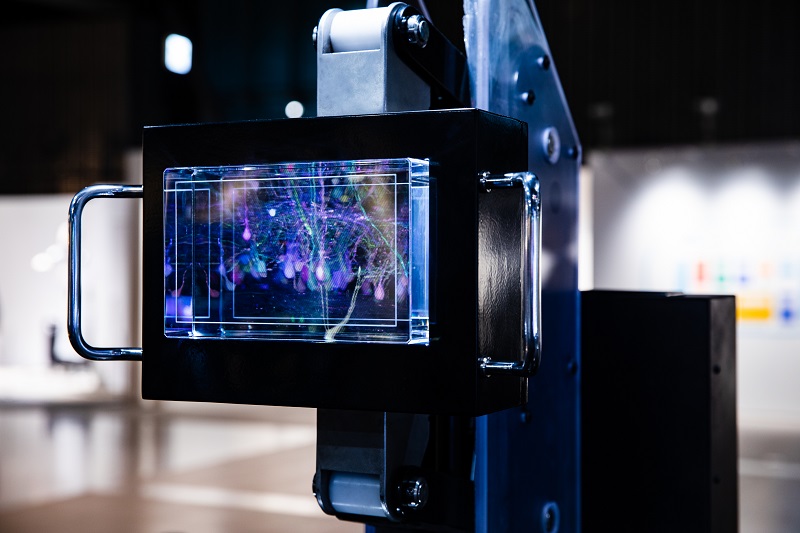
In this 3D image, the olfactory bulb region of a mouse's brain, which is responsible for processing its sense of smell, is made transparent, and the nerve cells within are colored to become visible. The branches of the nerve cells, called dendrites, reach out and connect together in many complex arrangements. Visualizing the mouse's brain in this way allows us to better understand its structure and function.
In the world of computers, "neural networks" are mathematical models similar to the biological neural networks found in nature. Just like natural neurons, the function of each neuron in a computer neural network is simple, but these neurons combine to enable a wide range of complex responses. Artificial neural networks were born from the concepts of nature, but now they are following their own independent path of evolution.

Related keywords
Stereo vision / Parallax barrier / Lenticular / Brain transparency / Dye / Neural network / Pulse transmission
Credits
Contributor: Takeshi Imai (Kyushu University)

When a person uses their vision to see the world, the information is digitized just like a picture taken with a digital camera. The lens of your eye focuses the light from the outside world onto your retina, the screen at the back of your eye. The nerve cells lined up in your retina transform the light into a digital signal of 0 or 1. If you perceive the world through digital signals of 0 and 1, does that mean you're a computer?
Related keywords
Ocular structure / Camera structure / Retina / Optic nerve / Optical processing (analog processing) / Quantization (digital processing) / Cameras today

If we train an artificial intelligence with a large number of color images, it can learn to color black and white images itself. In this exhibit, we present a combination of two technologies: one that is skilled at coloring an overall photo, and another is skilled at coloring the details of individual objects. We can use this technology to restore old black and white photos to the natural colors of their time. Computers can be used to surpass time and recreate the "nature" of the past.
Related keywords
Film shooting (development) / History of cameras / Video equipment / Monochrome / Convolutional neural network model / Color and shape
Credits
Collaborative Researcher: Satoshi Iizuka (University of Tsukuba)

Have you ever thought about the resolution of the world we are looking at? Our retina is lined with photoreceptors that capture light. The "real" space around us is extremely dense at the molecular and atomic level, but the world we see is limited by our number of photoreceptors. Compare the real tropical fish in this aquarium with those presented on the high-resolution display. If you cannot tell them apart, it is up to you to decide what is "real."
Related keywords
Life game / Second life / Pet robot / Resolution / Artificial mind

Technologies such as VR (virtual reality) and AR (augmented reality) make it possible to experience digital data in a way that feels closer to reality. As these technologies become more common in our lives, the way we view the world is bound to change drastically.
This exhibit uses a curved mirror called a "volmatrix mirror." The reflection of the mirror creates a floating holographic image of the object actually sitting at the bottom of the mirror. While this hologram is just a trick created with a mirror, researchers are developing digital technology that also allows stereoscopic, 3D viewing. If this technology comes to fruition, how will we experience "reality?"
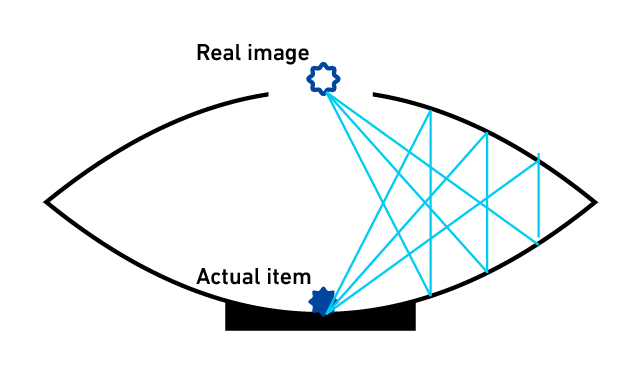
Related keywords
VR / AR / MR / 3D display / Mirror / Virtual / Physical / Tactile / Realism

Computers' processing and communication speeds are constantly improving, and computers, which were created by people, are present in all aspects of our lives. Before long, the computers that we have created will begin to be treated as “ natural”, to such an extent that we will no longer be conscious that we created them.
The resolutions achieved with reproduction technologies, such as displays and printing, are improving to the extent that it is becoming impossible to distinguish between reproductions and the real thing. Furthermore, printing technology is no longer simply a technology for printing words and pictures – it is now possible to precisely fabricate a variety of structures. Butterflies, known as morpho butterflies, are installed within the space. The complex colors that morpho butterflies emit are produced as a result of the reflection and interference of light on delicate structures engraved at the nano-level into the creatures’ scales and body surface. This exhibition intermixes specimens of actual butterflies, and artificial butterflies whose wings have been created using a procedure known as “structural color printing” and which incorporate a fluttering mechanism by imperceptibly changing light and energy. Which butterfly seems more “ natural,” the real one or the artificial one?
Intermediates that arise in the recycling process are enclosed within the variously shaped glass vases. Worn-out clothes are cut up into scraps of cloth, and these are melted into a liquid before being regenerated as chips of polyester. Just like a natural world cycle, artificial material used in clothing undergoes a cycle while changing its form, to be transformed into a raw material for new clothes. Meanwhile, computers are equipped with a function known as “garbage collection,” which frees up memory that is not being utilized and reuses it as free space. This function influences the energy that is consumed. If it’s true that nature involves the pursuit of sustainability, is it possible for computers that consume less power and pursue more cyclically efficient methods also conform to this flow of “ nature”?
Related keywords
Ikebana flower arrangement / Structural color / Printing technology / Resource recycling / Energy / Ubiquitous / Garden (nature with human artifacts)
Credits
Ikebana: YUKI TSUJI (Ikebana Artist, YUKI TSUJI + Plants Sculpture Studio Inc.)
Installation: Yoichi Ochiai (Media Artist, University of Tsukuba)
Structural Color Printing Provider: Toppan Printing Co., Ltd.
Butterfly Mechanical Structure Provider: Kokusai Display Kogyo Co.,Ltd.
Special Sponsors: JEPLAN, INC.

Artificial intelligence is expected to play a major role in image generation. An artificial intelligence (AI) can learn the common characteristics present in a large collection of images, and use those characteristics to create new images. This is not simply copying a picture, the AI creates a unique image not found anywhere else in the world.
Artificial intelligence can even learn minute, detailed features inexpressible by humans. This makes it possible for the AI to produce a wide variety of shapes, such as those of letters, and human and animal faces. In this video, we demonstrate an AI learning system called a "generative adversarial network (GAN)," in which one system creates images while another system compares those images with the originals simultaneously.

Related keywords
Image production / Deep learning / Generative adversarial network (GAN) / End to End / The realm of non-obstruction between phenomena
Credits
Video Content Production: Miracle Mile Inc., AIQ Corporation

There are two major kinds of resolutions: "spatial resolution" and "temporal (time) resolution." To effectively extract information from the real world and reproduce it as a moving image, it is important to record the level of focus used in the space, and the frequency used in the time. These scales determine the spatial and temporal resolution.
Information can be extracted in two ways, "analog" and "digital." Here, a Nipkow disk, also known as a mechanical television, demonstrates the analogue method. The Nipkow disk is subject to physical limitations - to increase the spatial resolution, we must increase the size of the disk, and to increase the temporal resolution, we must increase the rotational speed. The "digital" method is free from these physical constraints, although it does face its own limitations such as transmission speed. In this exhibit, images with different spatial resolutions are presented with a uniform transmission speed.
Related keywords
Analog / Digital / Sampling / Quantization / Nipkow disk / History of TV / Spatial resolution / Temporal resolution / Data volume

We human have created many tools and methods to solve problems, create more convenient things in our lives, and produce new value. There are two key thought processes behind this cycle. The first is to build up "experience" while making repeated improvements, and the second is to find a "natural law" and produce solutions based on that law.
If we replace "experience" with "data" and "laws" with "models," and look back at the development of humanity and our technology thus far, we can capture a glimpse of how computers might develop in the future taking over from humans. This exhibit explores the development of technology from the perspective of "experience" and "laws" using five topics as examples.
"Images":
Visual images have been developed with the goal of faithfully reproducing reality. The efforts to create photorealistic paintings and continously improve the resolution of camera photos are all part of that journey. Images have evolved even further to enter a virtual space of three dimensions subject to the flow of time, similar to reality. In this new space, we can now do much more than simply reproducing reality.
"Music":
The values we apply to listening and creating music are always changing. We have evolved from a time where everyone gathered in a single place to listen to a live performance, to an age where people used various devices to reproduce recorded music, to today, an age in which we can enjoy performances and voices created entirely by computer. Assuming the values we place on music will continue to change, what kind of music do you think will move the hearts of the people of the future?
"Computing":
The demand for computing has grown in every age, always outpacing the limits of the computing methods available at the time. This process has continuously spurred the development of computing forward. Today, the spotlight shines on artificial intelligence technology capable of machine learning. Artificial intelligence is made possible by converting the vast "experience" of humanity into data, and using it to train a machine. This training leads to the discovery of numerous laws. In the future, is it possible that these laws will all lead to a unified, general artificial intelligence?
"Transportation":
Humans continue to explore how we can physically move to far off locations both quickly and comfortably. The development of motive power and the spread of vehicles such as automobiles was an enormous leap forward in travel speed. When automated driving is fully realized, people will be freed from the burden of driving themselves, and we will see a future with almost no limits on movement.
"Telecommunication":
The evolution of communication has thus far been driven by our desire as humans to overcome distance, communicate without delay, all while improving quality. Now that the Internet has become part of the unquestioned infrastructure of our lives, we can pay very little attention to time, place, or communication bandwidth. In the future, computers will become the primary communicators, and communication between computers will become the force driving the development of telecommunications forward.
Related keywords
Experience and natural laws / Statistics and analysis / Hunter-gatherer society / Industrial society / Information society / Society 5.0
Credits
Scientific Advisors:
“Images”: Asa Ito (Tokyo Institute of Technology)
“Music”: Masataka Goto (National Institute of Advanced Industrial Science and Technology (AIST))
“Computing”: Masashi Sugiyama (RIKEN, The University of Tokyo)
“Transportation”: Shinpei Kato (The University of Tokyo, Tier IV, Inc.)
“Telecommunication”: Daiyuu Nobori (University of Tsukuba, IPA)
Illustration: Hikaru Ichijo
Contributor: BANDAI NAMCO Entertainment Inc.

The Asuka Beauties is a stunning mural from the Asuka period discovered on the wall of the Takamatsuzuka burial mound in 1972. The mural depicts women from the Asuka period in vivid, bright colors. The Asuka Beauties mural was unfortunately exposed to the outside air, causing the brightness of the original colors to be lost, but many hand-painted and digital image reproductions are available for people to enjoy.
Ever since cameras and printing technology were invented, people have continuously worked to increase the resolution of these technologies. As recordings become ever more minute and precise, the gap between the original and copied reproductions becomes smaller and smaller. With digital reproduction technology continuing to advance by leaps and bounds, there may come a time when we will have to consider what it means to be "the real thing."
Related keywords
Asuka Beauties / Takamatsuzuka burial mound / Reproduction / Digital predictive restoration / Authenticity / Virtual museum
Credits
Contributor: Kansai University Museum
Illustration: Kei Hagiwara

Takeda Shingen, a general from the Warring States period, is well known for the importance he placed on communication technologies. Shingen was the lord of a mountainous region, and he used smoke signals to communicate more efficiently than what could be achieved with horseback messengers. Each smoke signal outpost would transmit signals in a relay fashion, to create a vast network that could quickly share information over enormous distances.
The Internet we use for communication today bears many similarities to Shingen's smoke signal network. Individual nodes in the network transmit information to each other in relay fashion, without any central control, allowing information to quickly cross long distances. If a single node in the network stops functioning, communication can still continue using other nodes. The resilient spirit of the Warring States period still lives in our modern communication network.
Even in the future, when artificial intelligence has penetrated every corner of our society, information transmission will still be based on the principles forged by the fires of history.
Related keywords
Takeda Shingen / Smoke signals / Information transmission / Internet / WWW / Node
Credits
Contributor: TAKEDA CASTLE RUINS MUSEUM
Illustration: Kei Hagiwara

New technologies such as autonomous driving inspire both anticipation and anxiety. The arrival of new, convenient technology gradually renders previous tools and methods obsolete. These former technologies do not always disappear, though. Some of them continue to live in our cultures, and produce new, unforeseen value.
Horses have been kept by humans for over 6,000 years, and were widely used to aid humans in both agriculture and transport. Until the arrival of the powered engine, horses were one of the most important land-based transportation methods.
With the advent of the Industrial Revolution, however, many jobs were taken over by engine-powered machines, and the work for horses and the people who cared for them declined. Even so, in an age where automobiles are now the primary mode of transportation, many people still love riding horses. We can trust that horses will continue to be a cherished part of our culture well into the future.
Related keywords
Horses / Hatakeyama Shigetada / Hiyodorigoe Pass / Industrial Revolution / Automobile
Credits
Illustration: Kei Hagiwara
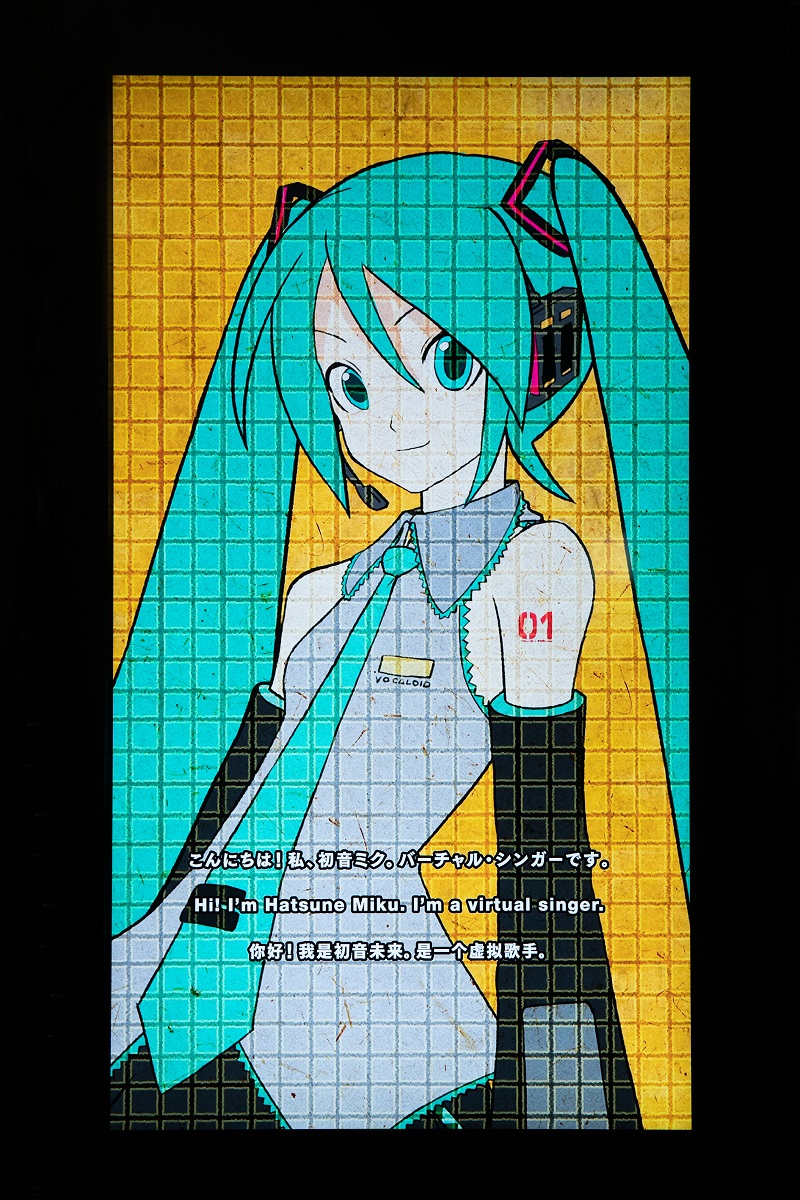
Hatsune Miku is the avatar of a line of voice synthesizer products that allow composers to create music using a computer, to be enjoyed as a digitally voiced song by others. The arrival of vocaloid (synthetic voice) engine capable of creating a "singing machine," represented by the popular Hatsune Miku, transformed the nature of music. As artificial intelligence continues to progress, we might see music autonomously created and sung by computers, an even greater change in how we create and enjoy music. What kind of music will the people of the future be listening to?
What is Hatsune Miku?
Hatsune Miku is a software created by Crypton Future Media, INC. that allows anyone to create songs by entering the lyrics and melody on their computer. Countless people created songs for Hatsune Miku, and created a viral movement by posting them to the Internet. Hatsune Miku has also garnered enormous popularity as a character, and now sports a wide variety of goods celebrating the virtual singer, and she can be seen in "live" concerts around the world and many other venues.
Related keywords
Hatsune Miku / Vocaloid / Virtual singer
Credits
Image & Voice Provider: CRYPTON FUTURE MEDIA, INC.
Illustration: Kei Hagiwara
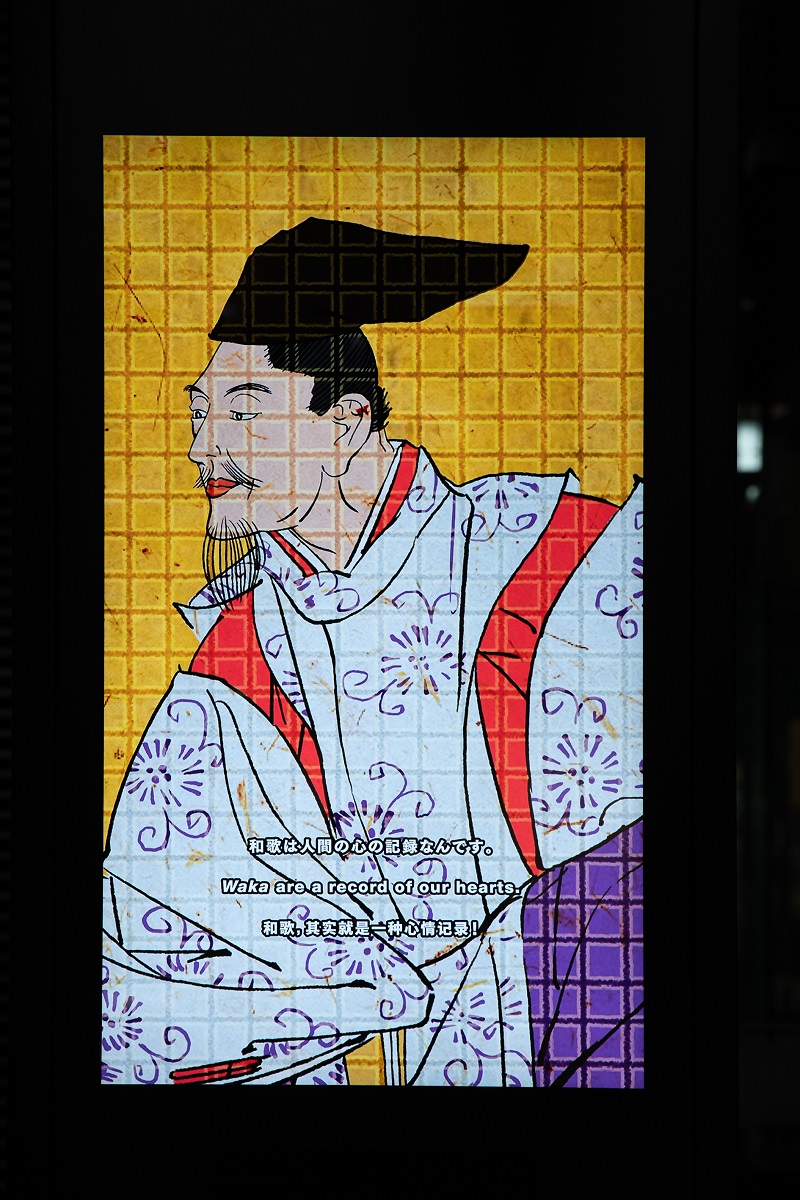
Waka is a traditional form of Japanese poetry composed of 31 syllables divided into a 5-7-5-7-7 pattern. Woven with words describing the seasons and nature, waka poems express the thoughts and feelings of many kinds of people. Ki no Tsurayuki is a famous poet and author from the Heian period, and he contributed greatly to the popularization of waka as a form of expression. People used waka to record and share their thoughts and feelings with others. Ki no Tsurayuki also pursued other progressive forms of expression, such as the Tosa Diary, a travel diary prized as a masterpiece of Japanese literature, composed primarily of waka poems.
Artificial intelligence (AI) can learn these varied forms of human expression, and create similar works of its own. Even if the form looks the same, however, can it also create the human heart that speaks through waka poems?
Related keywords
Ki no Tsurayuki / Waka / Tosa Diary / Recording / Sharing
Credits
Contributor: Robert Ono (Japan College of Social Work)
Illustration: Kei Hagiwara
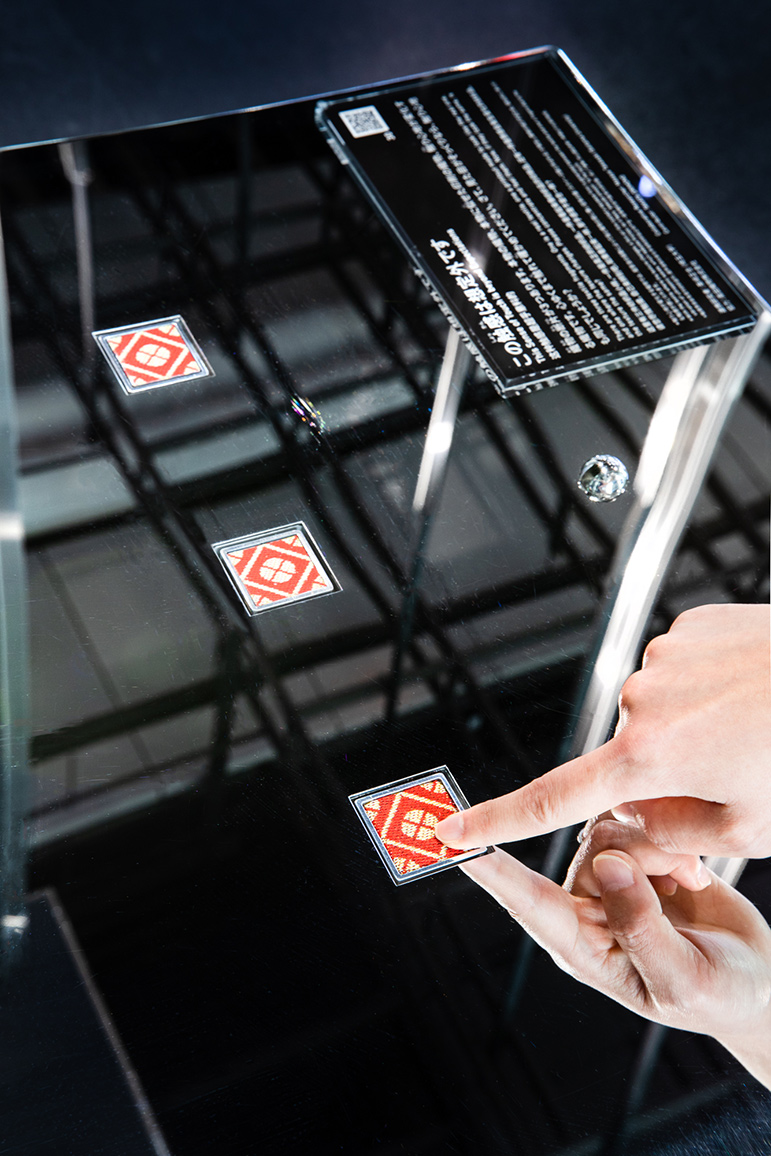
We can distinguish the texture of many materials by tracing the surface with our fingers. The difference in touch, such as smooth or rough, is due to the roughness of the material surface and the amount of friction that occurs between the material and our fingers. We receive changes and vibrations caused by the friction and other sensations on the skin of our fingers, as skin sensations. It is also possible to artificially control skin sensations.
This is called skin sensation display, and it can change the touch sensation of fingers that trace the touch display of tablets and smartphones. Using these technologies, research is being conducted on touch displays that can be operated just by touching them, displays that allow one to feel the texture of objects shown on the screens, and other devices.
Ultrasonic vibrations is one method for controlling skin sensations. Ultrasonic vibrations make it possible to give rough-surfaced materials a smoothness. A high-pressure air film called a “squeeze film” is formed on the surface of an object subjected to ultrasonic vibrations. The roughness of the material is covered by the squeeze film, and reduces finger contact, making it feel smoother to us.
In this exhibition, you can experience the change when the squeeze film effect is applied (a smooth feel) and when it is not (an uneven feel) on the same material. We have prepared a woven fabric used for tatami mats (left), a three-dimensional printout made to resemble it (right) and a three-dimensional printout where the sense of touch changes (center). Please touch and compare them.

Related keywords
Skin sensation display / Squeeze film effect / Ultrasonic vibrations
Credits
Collaborative researcher: Masaya Takasaki (Saitama University)
Contributor: TAKATA ORIMONO








